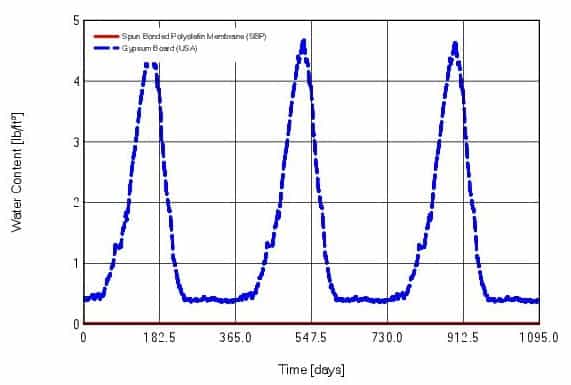Hygrothermal modeling uses a computer program to model the long-term effects of heat and moisture within and through parts of a building (construction assemblies). Hygrothermal is the combination of moisture and heat in building physics.
Why do Hygrothermal Modeling?
All building envelope assemblies (roofs and exterior walls) routinely have heat and moisture transfer over time. Typically, many roofing and exterior wall assemblies will “load up” with moisture during the winter months and “dry out” during the summer months. Hygrothermal modeling allows us to analyze this cycling and predict if it will become an issue or acceptable.
Hygrothermal Modeling Tools
WUFI Analysis

The industry-accepted hygrothermal modeling tool is WUFI. WUFI is a German acronym which stands for Wärme Und Feuchte Instationär, which translated means heat and moisture transiency. There are different versions of WUFI available. We use WUFI Pro 6.0 to model and predict how building envelope assemblies reached the condition they are in and predict how new assemblies will perform. As with any tool, the use of the WUFI program requires training. Experience in the building envelope industry is also a necessity.
Other Hygrothermal Modeling Tools
In addition to WUFI, we use traditional dew point and condensation analysis tools to validate WUFI models and existing conditions. We are also familiar with THERM, developed by the Lawrence Berkeley National Laboratory to model heat transfer in building components.
When should hygrothermal simulations be done?
Building Envelope Professionals Group (BEPG) utilizes hygrothermal modeling in several different situations. These applications include new construction, remodeling, building alterations, remediation, and forensics.
New Construction
Occasionally, an architect will want to design a wall or roof assembly that differs from a standard configuration. Or an architect may modify an existing wall or roof assembly. In both situations, they may not know how it will perform from a heat and moisture perspective.
Sometimes, a general contractor will want to change a designed assembly during the construction process. The contractor needs to know how their proposed changes will perform. Modeling an assembly before construction will help avoid condensation, mold, or other negative performance characteristics.
Remodeling or Building Alterations
When remodeling, we will use hygrothermal modeling to assess how well an existing assembly should perform. We then use the initial performance and analysis to modify potential changes or additions to that assembly. This hygrothermal simulation is beneficial in over-cladding. Over-cladding is installing a new system over an existing one. For example, installing a metal roof over an existing roof.
Remediation and Forensics
Similar to remodeling, we use hygrothermal modeling tools to determine why an existing assembly failed or doesn’t perform well. Often, this modeling determines if an existing roof or exterior wall system is modifiable to meet building requirements. It also assists in determining the design modifications or alterations necessary to make the assembly perform better.
